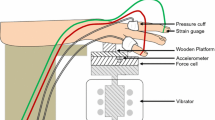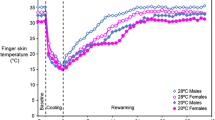Abstract
Objectives
Finger blood flow is reduced by hand-transmitted vibration but there has been little study of the peripheral vascular response to repetitive mechanical shocks. This study investigated how reductions in finger blood flow depend on shock repetition rate and the peak and rms magnitude of acceleration.
Methods
Subjects attended seven sessions: six with repetitive mechanical shocks and a control session with no shocks. Each session comprised five successive 5-min periods: (1) no force and no vibration, (2) force and no vibration, (3) force and vibration, (4) force and no vibration and (5) no force and no vibration. During the second–fourth periods, the palm of the right hand applied 2-N force to a vibrator. During the third period, a 125-Hz mechanical shock was applied with one of four repetition rates (1.3, 5.3, 21 or 83.3/s) and one of three acceleration magnitudes (2.5, 5 or 10 ms−2 rms, unweighted). Finger blood flow was measured every 30 s in the middle and little fingers of the right (exposed) hand and the left (unexposed) hand.
Results
Different repetition rates (1.3–83.3 s−1) and different peak magnitudes (10–88 ms−2 peak) but the same rms acceleration (10 ms−2 rms) caused similar decreases in blood flow in fingers on exposed and unexposed hands. Shocks with a 83.3 s−1 repetition rate, peak magnitude of 10 ms−2 and rms acceleration of 10 ms−2 provoked greater reduction in finger blood flow than shocks with the same peak magnitude but lower repetition rate (21 or 5.3 s−1) and lower rms acceleration (5 or 2.5 ms−2).
Conclusions
For shocks similar to those based on 125-Hz oscillations with repetition rates between 1.3 and 83.3 s−1, acute reductions in finger blood flow can be predicted from the rms acceleration.



Similar content being viewed by others
References
Ando H, Nieminen K, Toppila E, Starck J, Ishitake T (2005) Effect of impulse vibration on red blood cells in vitro. Scand J Work Environ Health 31:286–290
Bovenzi M, Lindsell CJ, Griffin MJ (1998) Duration of acute exposures to vibration and finger circulation. Scand J Work Environ Health 24:130–137
Bovenzi M, Lindsell CJ, Griffin MJ (1999) Magnitude of acute exposures to vibration and finger circulation. Scand J Work Environ Health 25:278–284
Bovenzi M, Lindsell CJ, Griffin MJ (2000) Acute vascular response to the frequency of vibration transmitted to the hand. Occup Environ Med 57:422–430
Bovenzi M, Lindsell CJ, Griffin MJ (2001) Response of finger circulation to energy equivalent combinations of magnitude and duration of vibration. Occup Environ Med 58:185–193
Bovenzi M, Welsh AJL, Griffin MJ (2004) Acute effects of continuous and intermittent vibration on finger circulation. Int Arch Occup Environ Health 77:255–263
Bovenzi M, Welsh AJL, Della Vedova A, Griffin MJ (2006) Acute effects of force and vibration on finger blood flow. Occup Environ Med 63:84–91
Concettoni E, Griffin MJ (2009) The apparent mass and mechanical impedance of the hand and the transmission of vibration to the fingers, hand and arm. J Sound Vib 325:664–678
Dupuis H, Schäfer N (1986) Effects of impulse vibration on the hand-arm system. Scand J Work Environ Health 12:320–322
Elashoff JD (2007) nQuery advisor: version 7.0. User’s guide. Statistical Solutions Ltd, Cork
Greenfield ADM, Whitney RJ, Mowbray JF (1963) Methods for the investigation of peripheral blood flow. Br Med Bull 19:101–109
Griffin MJ, Welsh AJL, Bovenzi M (2006) Acute response of finger circulation to force and vibration applied to the palm of the hand. Scand J Work Environ Health 32:383–391
International Organization for Standardization (2001) Mechanical vibration: measurement and evaluation of human exposure to hand-transmitted vibration—Part 1: general requirements. ISO 5349-1
Lindell H, Lönnroth I, Ottertun H (1998) Transient vibrations from impact wrenches cause damages on blood cell and the effects are not taken into account by ISO 5349. In: Lundström R, Burström L, Nilsson T, Bylund S (eds) Proceedings of the 8th international conference on hand-arm vibration, Umeå, Sweden, pp 33–34
Schäfer M, Dupuis H, Hartung E (1984) Acute effects of shock-type vibration transmitted to the hand-arm system. Int Arch Occup Environ Health 55:49–59
Thompson AJL, Griffin MJ (2009) Effect of the magnitude and frequency of hand transmitted vibration on finger blood flow during and after exposure to vibration. Int Arch Occup Environ Health 82:1151–1162
Conflict of interest
The authors declare that they have no conflict of interest.
Author information
Authors and Affiliations
Corresponding author
Rights and permissions
About this article
Cite this article
Ye, Y., Mauro, M., Bovenzi, M. et al. Acute effects of mechanical shocks on finger blood flow: influence of shock repetition rate and shock magnitude. Int Arch Occup Environ Health 85, 605–614 (2012). https://doi.org/10.1007/s00420-011-0704-x
Received:
Accepted:
Published:
Issue Date:
DOI: https://doi.org/10.1007/s00420-011-0704-x




